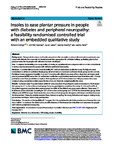Insoles to ease plantar pressure in people with diabetes and peripheral neuropathy: a feasibility randomized controlled trial with an embedded qualitative study
| dc.contributor.author | Collings, R | |
| dc.contributor.author | Freeman, J | |
| dc.contributor.author | Latour, J | |
| dc.contributor.author | Hosking, J | |
| dc.contributor.author | Paton, J | |
| dc.date.accessioned | 2023-02-13T13:28:25Z | |
| dc.date.issued | 2023-02-03 | |
| dc.identifier.issn | 2055-5784 | |
| dc.identifier.issn | 2055-5784 | |
| dc.identifier.other | 20 | |
| dc.identifier.uri | http://hdl.handle.net/10026.1/20295 | |
| dc.description.abstract |
<jats:title>Abstract</jats:title><jats:sec><jats:title>Background</jats:title><jats:p>Therapeutic footwear and insoles are preventative strategies to reduce elevated plantar pressures associated with diabetic foot ulcer risk. An insole intervention appropriate for chairside delivery optimising plantar foot pressure reduction in people with diabetes has been developed.</jats:p></jats:sec><jats:sec><jats:title>Aim</jats:title><jats:p>To explore the feasibility and acceptability of testing an optimised insole compared with an active control insole to reduce plantar pressures for people with diabetic peripheral neuropathy.</jats:p></jats:sec><jats:sec><jats:title>Methods</jats:title><jats:p>A double-blinded multi-centre feasibility RCT with an embedded qualitative study. Participants were randomised to either an optimised insole group (intervention) or a standard cushioned insole group (active control). Participants were assessed at baseline, 3, 6, and 12 months with clinical outcomes of foot ulceration and mean peak plantar pressure (MPPP) reduction. An embedded qualitative study involved semi-structured interviews with 12 study participants and three podiatrists to explore their experiences of the intervention and trial procedures. Data were analysed using descriptive statistics (quantitative data) and thematic analysis (qualitative data).</jats:p></jats:sec><jats:sec><jats:title>Results</jats:title><jats:p>Screened were142 patients from which 61 were recruited; 30 participants were randomised to the intervention group and 31 to the active control group. Forty-two participants completed the study. At 12 months, 69% of the patient-reported questionnaires were returned and 68% of the clinical outcomes were collected. There were 17 incidences of foot ulceration occurring in 7/31 of the active control group and 10/30 in the intervention group. Mean difference in MPPP between the intervention and active control groups for all regions-of-interest combined favoured the intervention. Thematic analysis revealed three themes; accepting the study, behaviour and support during study procedures, and impact from study participation.</jats:p></jats:sec><jats:sec><jats:title>Conclusion</jats:title><jats:p>The results of the feasibility RCT suggest that the optimised insole holds promise as an intervention, and that a full RCT to evaluate the clinical and cost-effectiveness of this intervention is feasible and warranted for people with diabetic peripheral neuropathy.</jats:p></jats:sec><jats:sec><jats:title>Trial registration</jats:title><jats:p>International Standard Randomised Controlled Trial Number:<jats:ext-link xmlns:xlink="http://www.w3.org/1999/xlink" ext-link-type="uri" xlink:href="https://www.isrctn.com/ISRCTN16011830">ISRCTN16011830</jats:ext-link>. Registered 9th October 2017.</jats:p></jats:sec> | |
| dc.format.extent | 20- | |
| dc.format.medium | Electronic | |
| dc.language | en | |
| dc.language.iso | en | |
| dc.publisher | BioMed Central | |
| dc.subject | Diabetic foot | |
| dc.subject | Prevention | |
| dc.subject | Offloading | |
| dc.subject | Insole | |
| dc.subject | Feasibility | |
| dc.title | Insoles to ease plantar pressure in people with diabetes and peripheral neuropathy: a feasibility randomized controlled trial with an embedded qualitative study | |
| dc.type | journal-article | |
| dc.type | Article | |
| plymouth.author-url | https://www.ncbi.nlm.nih.gov/pubmed/36737812 | |
| plymouth.issue | 1 | |
| plymouth.volume | 9 | |
| plymouth.publication-status | Published online | |
| plymouth.journal | Pilot and Feasibility Studies | |
| dc.identifier.doi | 10.1186/s40814-023-01252-y | |
| plymouth.organisational-group | /Plymouth | |
| plymouth.organisational-group | /Plymouth/Faculty of Health | |
| plymouth.organisational-group | /Plymouth/Faculty of Health/School of Nursing and Midwifery | |
| plymouth.organisational-group | /Plymouth/REF 2021 Researchers by UoA | |
| plymouth.organisational-group | /Plymouth/REF 2021 Researchers by UoA/UoA03 Allied Health Professions, Dentistry, Nursing and Pharmacy | |
| plymouth.organisational-group | /Plymouth/Research Groups | |
| plymouth.organisational-group | /Plymouth/Research Groups/Institute of Health and Community | |
| plymouth.organisational-group | /Plymouth/Research Groups/Plymouth Institute of Health and Care Research (PIHR) | |
| plymouth.organisational-group | /Plymouth/Users by role | |
| plymouth.organisational-group | /Plymouth/Users by role/Academics | |
| plymouth.organisational-group | /Plymouth/Users by role/Researchers in ResearchFish submission | |
| dc.publisher.place | England | |
| dcterms.dateAccepted | 2023-01-28 | |
| dc.rights.embargodate | 2023-2-15 | |
| dc.identifier.eissn | 2055-5784 | |
| dc.rights.embargoperiod | Not known | |
| rioxxterms.funder | National Institute for Health Research | |
| rioxxterms.identifier.project | Reducing Foot Plantar Pressure (ReFPres) in people with diabetes using an instant insole solution: a mixed methods pilot study. | |
| rioxxterms.versionofrecord | 10.1186/s40814-023-01252-y | |
| rioxxterms.licenseref.uri | http://www.rioxx.net/licenses/all-rights-reserved | |
| rioxxterms.type | Journal Article/Review | |
| plymouth.funder | Reducing Foot Plantar Pressure (ReFPres) in people with diabetes using an instant insole solution: a mixed methods pilot study.::National Institute for Health Research |


